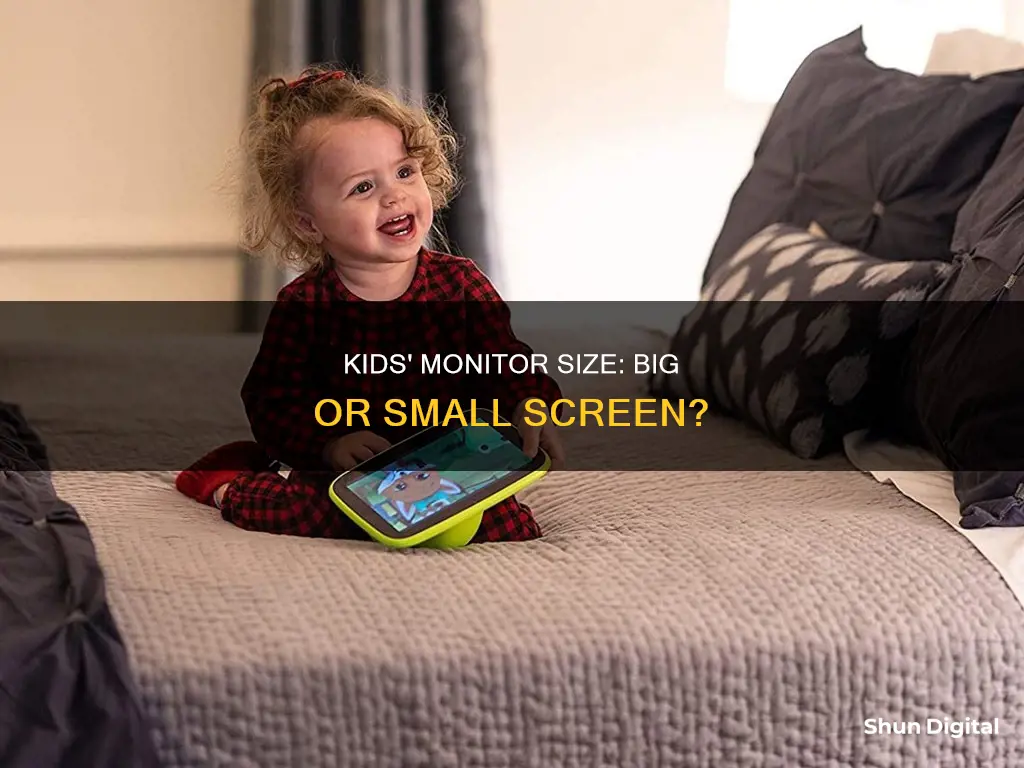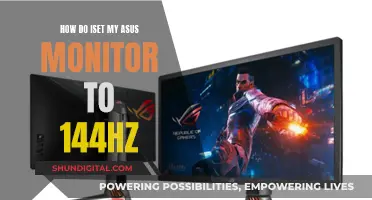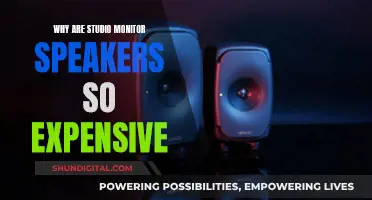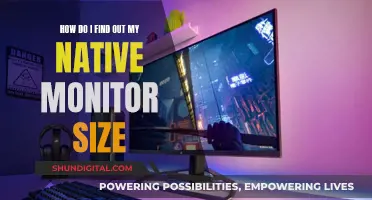
When it comes to kids and screen time, bigger is always better for their eye development. Optometrists and eye specialists recommend larger screens over smaller ones as smaller gadgets are held closer to children's faces, causing their eyes to work harder to focus and turn in so they can see clearly. Screens that are 24 inches or larger are ideal for kids, with 24 inches being the baseline for everyday use. While 27-inch screens are great for gaming and movies, they may not be suitable for smaller desks. For smaller desks, a 22-inch monitor is more suitable as it provides ample screen space without taking up too much room.
| Characteristics | Values |
|---|---|
| Screen size | 22 inches, 24 inches, 27 inches, 29 inches, 32 inches, 34 inches, 38 inches, 49 inches |
| Viewing distance | Not too close or too far away from the screen |
| Desk size | The monitor should fit on the desk |
| Eye development | Smaller screens require children to strain their eyes to focus |
What You'll Learn

Screen size impacts eye development
The size of a screen has a significant impact on a child's eye development. Eye specialists recommend larger screens over smaller ones for children, as the latter can strain their eyes and hinder proper eye development.
The Impact of Screen Size on Eyes
When children use smaller screens, they tend to hold the device closer to their faces. This proximity requires their eyes to work harder to focus, causing strain. The eyes have to turn inwards to see clearly, and the posture of looking up can make it even more challenging for the eyes to relax and focus.
Dr. Nathan Bonilla-Warford, an optometrist specializing in children's eye development, emphasizes that the smaller the screen, the fewer children should be using it. He compares it to reading a book, where natural breaks like turning pages or moving to a new paragraph allow the eyes to reset and relax.
Recommended Screen Sizes for Children
To promote healthy eye development and reduce eye strain, larger screens are preferable for children. Here are some recommended options for viewing:
- Preferred: Television screens are the best option as they allow for a comfortable viewing distance and discourage children from holding the device too close to their faces.
- Next Best: Computer screens, iPads, or tablets placed on a table are suitable. Placing the device on a table helps maintain a neutral body posture with less stress.
- Least Preferred: Handheld devices, such as cell phones, are not recommended. These devices are typically held very close to the eyes, causing strain and requiring the eyes to work harder to focus.
Additional Considerations
While screen size is crucial, it is also essential to consider other factors for healthy screen habits in children:
- Limit Screen Time: Establish boundaries and follow age-appropriate recommendations for screen time. The American Academy of Pediatrics suggests limiting screen use for 2- to 5-year-olds to one hour per day of high-quality children's programs.
- Parental Engagement: Engage with your child during screen time. Watch together and talk about what they are viewing, relating it to real-life situations and promoting social development.
- Encourage Movement: Encourage your child to take regular breaks, stretch, and change their posture to avoid pain and promote good posture.
Monitoring Xbox Usage: Remote Control for Parents
You may want to see also

24-inch monitors are the baseline
When it comes to choosing a monitor for kids, there are a few things to consider. Firstly, it's important to strike a balance between size and quality. While you want a monitor that is big enough for comfortable viewing, it shouldn't be so large that it becomes awkward or too big for the space. This is especially important if you're setting up a monitor for a child, as you'll want to ensure that it is comfortable and safe for them to use.
In terms of specific sizes, 24-inch monitors have long been the baseline when it comes to computer monitors. This is partly because 24 inches was the most common size available for a long time, and it's what you would typically find in homes and offices. While there are now larger options available, such as ultrawide and curved monitors, a 24-inch monitor is still a great choice for a variety of reasons.
Firstly, 24-inch monitors are very affordable. You can easily find options starting at around £70, which is great if you're on a budget. Secondly, this size is very versatile. It's perfect for casual web browsing, watching videos, and working on documents. Additionally, if you're looking to set up multiple monitors or a laptop-monitor combination, 24 inches is a great size as it's easy to fit two or even three monitors on your desk without taking up too much space.
For gaming, a 24-inch monitor can also be a good choice. Many gaming pros prefer a more compact setup so that they can keep their game in their peripheral vision. With a larger monitor, you may find yourself craning your neck to see everything on the screen, which can slow down your reaction time.
When it comes to resolution, 1080p is the most popular option and it will look sharp and clear on a 24-inch monitor. If you go for a larger monitor, you may start to notice some pixelation with 1080p, but on a 24-inch screen, it will look great.
Overall, a 24-inch monitor is a great baseline option. It offers a good balance between size and quality, and it's very affordable. Whether you're looking for a casual browsing experience, a gaming setup, or a multi-monitor arrangement, a 24-inch monitor will serve you well.
Cox Internet Monitoring: What You Need to Know
You may want to see also

27-inch monitors are increasingly popular
In terms of gaming, 27-inch monitors often come with features like high refresh rates and HDMI 2.1 bandwidth, which enhance the gaming experience. For productivity, 27-inch monitors can be useful for multitasking, as they offer enough space to place two windows side-by-side. Additionally, many 27-inch monitors come with extra features like USB hubs and ergonomic stands, making them even more appealing for everyday use.
Another advantage of 27-inch monitors is that they are available in a range of resolutions, from 1080p to 4K. This means that users can choose the resolution that best suits their needs, whether it's for gaming, photo or video editing, or general office work.
While there are now bigger displays on the market, 27-inch monitors remain a common and popular choice due to their versatility, performance, and reasonable pricing. They strike a good balance between size and functionality, making them a great option for those who want a capable monitor without sacrificing desk space.
Monitoring SSRS Report Usage: Strategies for Performance Analysis
You may want to see also

Ultrawide monitors are great for gaming
For kids, smaller screens can stunt eye development as children tend to hold gadgets closer to their faces.
The Dell Alienware AW3423DWF is a great choice for an ultrawide gaming monitor. It has a 34-inch screen with an 1800R curve, bringing the edges closer to your field of vision, especially if you're sitting close to the monitor. It also boasts a near-instantaneous response time and a 165Hz refresh rate for smooth and responsive gameplay.
If you're looking for a more responsive monitor that performs well in bright rooms, the LG 34GS95QE-B is a good option. It has a 34-inch screen and a more aggressive 800R curve, bringing the edges even closer to your field of vision. It also features a higher 240Hz refresh rate and a rapid response time, making it ideal for competitive gaming.
For a budget-friendly option, the Dell S3422DWG is a fantastic choice. It has a 144Hz refresh rate and a 34-inch screen, delivering smooth gameplay and an immersive experience. While it has more smearing with fast-moving objects, its overall response time is good, and it includes a backlight strobing feature to reduce persistence blur.
When choosing an ultrawide monitor for gaming, consider your budget, the monitor's response time, and the VRR formats it supports to ensure compatibility with your PC. Keep in mind that game consoles don't support ultrawide aspect ratios, so these monitors are best for PC gaming.
Troubleshooting an ASUS Monitor: Persistent Flickering Issue
You may want to see also

32-inch monitors are good for console gaming
When it comes to kids, screen time should be limited, and the size of the screen should be adequate to prevent any adverse effects on their eye development.
Now, 32-inch monitors are good for console gaming. They offer a more immersive gaming experience than smaller displays, and they usually have a 4K or 1440p resolution. Premium models tend to have HDMI 2.1 bandwidth, which allows you to take full advantage of modern graphics cards or gaming consoles. The higher resolution provides much greater screen detail thanks to the increased pixel density. This is one of the key benefits of having a larger screen.
The LG Ultragear 32GN600-B is a great option for console gaming. It offers a native 1440p resolution with a 165Hz refresh rate, 1ms (MBR) response time, and support for both FreeSync and G-Sync. It has excellent out-of-the-box calibration and great contrast, delivering impressive colour reproduction and covering 95% of the sRGB colour gamut. It also has a clean and simple design, but the stand only offers tilt adjustment.
The Samsung 32-inch G7 is another excellent choice for a 32-inch gaming monitor. It features a speedy 240Hz refresh rate VA panel with 1440p native resolution. It covers 100% of the sRGB space, 85% of AdobeRGB, and 90% of the DCI-P3 space, and it gets fairly bright. The curved design offers an immersive gaming experience, and the VA panel delivers sharp, smear-free images even at high refresh rates.
The Gigabyte M32U is another standout 32-inch 4K gaming monitor. It offers an excellent selection of ports, including HDMI 2.1, which makes it a great choice for consoles like the PlayStation 5 and Xbox Series X. It also has a DisplayPort 1.4 connection offering a 144Hz refresh rate at 4K and a USB-C input port. It delivers excellent post-calibration colour accuracy, with 123% coverage of sRGB and 90% coverage of DCI-P3. However, its HDR performance is mediocre.
The Dell S3222HG is a good option if you're specifically looking for a 32-inch gaming monitor with a 1080p resolution. It features a curved VA panel for an immersive look and feel, and it offers a 165Hz refresh rate, Adaptive-Sync, and a 4ms response time. It delivers great picture quality and impressive colour reproduction, covering 99% of the sRGB colour gamut. It includes two HDMI 2.0 ports, a DisplayPort 1.2, and a 3.5mm jack for headphones.
Enhancing Your ASUS Monitor: Adding Speakers for Immersive Audio
You may want to see also
Frequently asked questions
For kids, a monitor size of 22 inches is suitable for a student house or business use. A 24-inch monitor is the default size for everyday use, office tasks, and school. A 27-inch monitor provides ample screen space and is great for gaming, graphic design, and image editing.
Bigger screens are better for kids' eye development. Optometrists specializing in children's eye development recommend larger screens as smaller gadgets are held closer to kids' faces, causing their eyes to work harder to focus and turn in to see clearly.
Smaller monitors are suitable for kids if space is limited. A compact monitor is preferable if you have a small desk or minimal space for desktop PC setup.
In addition to screen size, consider the viewing distance, desk size, resolution, and intended use. Ensure the monitor provides a comfortable viewing experience without causing eye strain. For gaming and media consumption, larger monitors are preferred, while smaller monitors are adequate for basic tasks like browsing the internet or working on documents.







